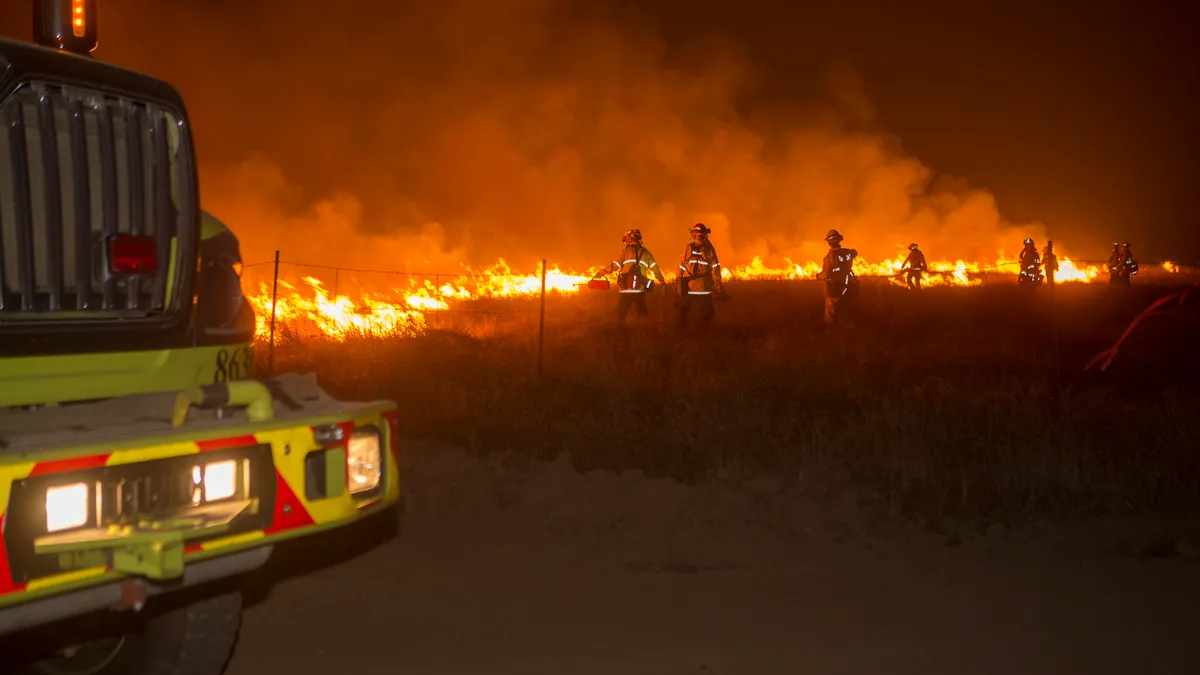Dive Brief:
- The California Public Utilities Commission issued a number of proposed decisions Monday to approve utility wildfire mitigation plans, rushing to get safety precautions in place as the state heads into the 2019 fire season.
- The approvals cover the state's three large investor-owned utilities (IOUs) along with a pair of independent transmission owners and other entities, and conclude the proposed wildfire plans comply with a state law, SB 901, directing utilities to enhance safety. Pacific Gas and Electric (PG&E) and Southern California Edison (SCE) both had areas of their plans flagged for necessary improvements, including asking PG&E for an expanded strategy on how it can avoid de-energization.
- The orders would direct the "electrical corporations" to track data and assess outcomes so that future plans can be improved. Regulators could vote on the proposed orders May 30.
Dive Insight:
California utilities have launched extensive inspection and grid hardening campaigns, and while regulators say there is room for improvement, they also concluded the 2019 plans comply with SB 901, which also requires detailed proposals to combat and respond to catastrophic wildfires.
"Electrical corporations are but a piece of the puzzle to mitigating catastrophic wildfires, and the problem of wildfires will not be solved in one year," regulators said in a statement released alongside the proposed orders. "But the CPUC is diligently focused on ensuring improvements in the utility Wildfire Mitigation Plans each year through engineering, technological advances, and lessons learned from previous years."
Regulators noted seven areas where PG&E's plan requires improvement, including "better metrics for analyzing how PG&E’s proposed mitigation measures fit together, as well as the individual effectiveness of each measure." More specifically, the commission wants PG&E to study whether recloser disabling, along with other mitigation measures, could reduce the need for proactive de-energizations, known as Public Safety Power Shutoffs (PSPS).
Disabling a recloser would keep lines from automatically attempting to re-energize after a fault, which could spark a wildfire if the line is in contact with vegetation.
PG&E last week proposed revisions to its fire mitigation plan, including the removal of hard deadlines for some inspections and corrective actions. In that filing, the utility described the potential widespread impacts of calling a PSPS, potentially meaning blackouts throughout San Francisco.
The commission, separately, has proposed guidelines for how IOUs must notify customers in the event of a PSPS. Proactive de-energization of power lines in times of high winds could be a key strategy to reducing wildfire risk, but regulators say it can only be used "as a measure of last resort."
The CPUC highlighted PG&E's revisions, noting the utility is "proposing to extend the timelines on many of its major wildfire mitigation efforts. We do not act on those proposals in this decision since they were filed too late to be considered and to receive party comment."
PG&E is still reviewing the proposed decision and plans to keep regulators, the public and other stakeholders informed "as we complete this critical safety work and execute our plan to reduce the wildfire risk in our service area," the utility said in a statement to Utility Dive.
The commission noted three areas in Edison's plan for improvement, including the utility's reliance on two sets of fire threat maps and the need to verify that a covered conductor program will occur during this fire mitigation plan cycle. Regulators said they also want an explanation of SCE's Enhanced Overhead Inspection program "to ensure it does not simply consist of drive-by patrols."
The fire mitigation plan filed by San Diego Gas & Electric passed commission muster without being tagged for improvements. The proposed order notes the plan "consists of an overview of work that SDG&E has already undergone to prepare and harden its system to prevent future wildfires."
In a statement to Utility Dive, SDG&E noted that it "is considered to be an industry leader in wildfire preparedness and mitigation." Since 2007, the utility has invested $1.5 billion on wildfire mitigation and grid resiliency.
"This includes robust efforts to fire harden our electric infrastructure, enhance situational awareness (we have built networks of weather stations and fire-monitoring cameras), update operating procedures and protocols, and build community partnerships to improve our region’s overall ability to respond to wildfires," SDG&E said.
A timeline for CPUC implementation of SB 901 targets May 2019 for approval of the plans, "with ongoing review to ensure compliance." The state's wildfire season typically begins in mid-summer.















